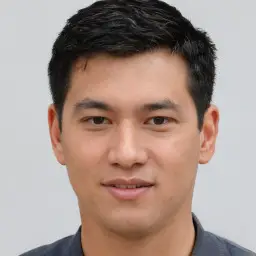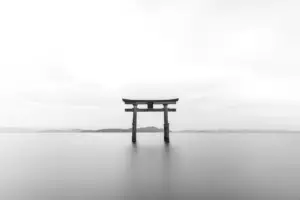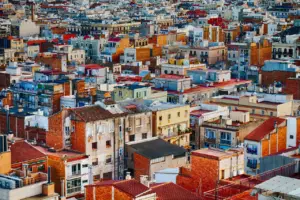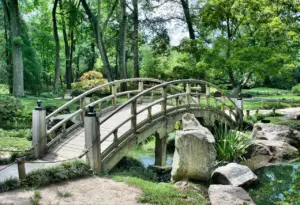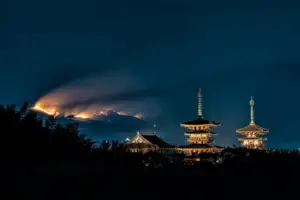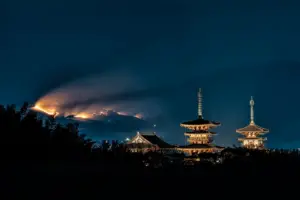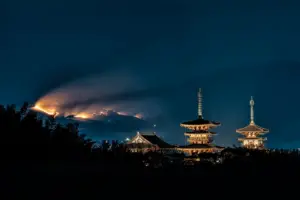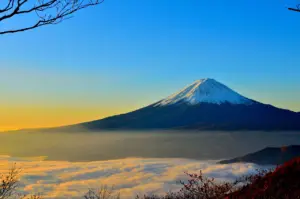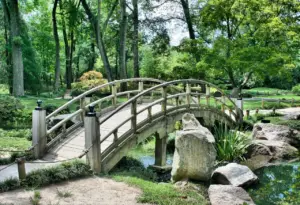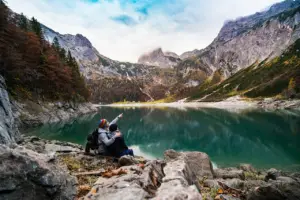Are you looking for a spiritual journey that will take you through some of the most beautiful and culturally rich areas of Japan? Look no further than these seven pilgrimage routes, each with its own unique history and significance.
From the ancient Shikoku Pilgrimage to the stunning Kumano Kodo, these routes offer the perfect opportunity for self-reflection, cultural immersion, and physical challenge.
The Shikoku Pilgrimage is one of the most famous and challenging pilgrimage routes in Japan. This 88-temple route takes you through the stunning countryside of Shikoku Island, where you will encounter beautiful temples, dramatic mountains, and welcoming locals.
If you’re looking for a more peaceful and introspective journey, consider the Omine Okugake Trail, which takes you through the sacred mountains of Nara and Wakayama prefectures.
Whatever your spiritual or physical goals may be, these seven pilgrimage routes offer an unforgettable experience that will leave you feeling inspired and refreshed.
Key Takeaways
- Japan offers seven pilgrimage routes for spiritual exploration, each with its own unique history, significance, and challenges.
- Pilgrimage routes serve as a way for individuals to seek spiritual enlightenment and deepen their understanding of religious teachings, and have been traveled by people from all walks of life.
- Proper preparation and respect for local culture and customs is important before embarking on a pilgrimage route.
- The pilgrimage routes in Japan offer a unique blend of natural beauty, cultural significance, and spiritual exploration, making them a must-visit destination for those seeking inner peace and enlightenment.
Shikoku Pilgrimage
If you’re looking for a transformative journey, you can’t miss the Shikoku Pilgrimage – it’s an experience that’ll leave you feeling renewed and inspired!
This pilgrimage is a 1,200-kilometer journey that takes you through the 88 temples of Shikoku Island. It’s believed that completing this pilgrimage will lead to spiritual enlightenment and a deeper connection with oneself.
The Shikoku Pilgrimage has been around for over 1,200 years and is deeply rooted in Japanese culture. The journey is divided into four courses, each of which takes you through various temples and towns.
Along the way, you’ll meet other pilgrims and locals who will offer you hospitality and guidance. This pilgrimage is not easy, but it’s incredibly rewarding. You’ll be challenged physically, mentally, and spiritually, but you’ll come out on the other side with a newfound appreciation for life and a sense of inner peace.
Kumano Kodo
If you’re looking for a spiritual journey in Japan, you should definitely explore the Kumano Kodo.
This ancient pilgrimage route dates back over 1000 years and is considered one of the most sacred sites in Japan.
Highlights of the route include beautiful mountain views, traditional hot springs, and stunning shrines and temples.
For pilgrims, it’s important to pack light, wear comfortable shoes, and bring plenty of water for the hike.
History and Significance
You’ll gain a greater understanding of the spiritual significance behind Japan’s pilgrimage routes by exploring their rich history. The Kumano Kodo has been walked by emperors, samurai, and commoners alike for over 1,000 years. It was believed to be a sacred path that led to the Kumano Sanzan, three grand shrines that were considered the birthplace of Japan’s spiritual traditions.
To truly appreciate the significance of the Kumano Kodo, it’s important to understand the historical context in which it was created. The route was established during the Heian period (794-1185) when the imperial court in Kyoto began to recognize the power and influence of the Kumano Sanzan. It became a popular pilgrimage destination for those seeking spiritual enlightenment and a deeper connection with the divine.
Today, the Kumano Kodo continues to be a popular pilgrimage route for people from all over the world. It offers a unique opportunity to explore the rich spiritual traditions of Japan.
Highlights of the Route
Get ready to experience the breathtaking beauty of the Kumano Kodo trail, where you’ll be surrounded by lush forests, majestic waterfalls, and ancient shrines that transport you to a different time and place. This pilgrimage route has been a sacred destination for centuries, and it’s easy to see why. The trail spans over 1,000 years of history and culture, passing through stunning landscapes and offering a glimpse into the rich spiritual traditions of Japan.
One of the highlights of the Kumano Kodo trail is the Kumano Sanzan, a trio of grand shrines that have been designated as World Heritage Sites. These shrines, located in the rugged mountains of the Kii Peninsula, have been a place of worship for over 1,000 years. Each shrine is unique in its own way, with its own distinctive architecture and history. The Kumano Sanzan is a testament to the enduring faith of the Japanese people and an awe-inspiring sight for those who visit. To fully appreciate the beauty and significance of this pilgrimage route, take a look at the table below which highlights some of the key landmarks and experiences along the way.
| Landmark | Description | Emotion |
|---|---|---|
| Nachi Falls | A majestic waterfall that is over 130 meters tall | Awe |
| Kumano Sanzan | A trio of grand shrines that have been designated as World Heritage Sites | Reverence |
| Hongu Taisha | The largest of the Kumano Sanzan shrines, with a stunning torii gate | Humility |
| Yunomine Onsen | A hot spring town with a history that dates back over 1,800 years | Relaxation |
| Koyasan | A mountain-top temple town that is the birthplace of Shingon Buddhism | Enlightenment |
As you journey along the Kumano Kodo trail, you’ll be struck by the beauty of the natural scenery and the deep spirituality that permeates the landscape. Whether you’re seeking a deeper connection with nature or a new perspective on life, this pilgrimage route offers a transformative experience that is sure to stay with you long after you’ve returned home.
Tips for Pilgrims
Ready to embark on the Kumano Kodo trail? Here are some tips to help make your journey a success!
-
Plan ahead: Make sure to research the trail and plan your itinerary in advance. This includes booking accommodations, packing appropriate gear, and arranging transportation.
-
Stay hydrated: The trail can be physically demanding, so it’s important to stay hydrated by carrying plenty of water and electrolyte drinks.
-
Respect the culture: The Kumano Kodo trail is not just a physical journey, but a spiritual one as well. Be respectful of the local culture and customs, such as bowing at shrines and wearing appropriate clothing.
-
Take breaks: Don’t push yourself too hard and remember to take breaks when needed. Take time to appreciate the natural beauty and spiritual significance of the trail.
Embarking on a pilgrimage can be a life-changing experience. By following these tips, you can ensure a successful and meaningful journey on the Kumano Kodo trail. So get ready to step out of your comfort zone, challenge yourself physically and spiritually, and embrace the beauty of Japan’s ancient pilgrimage routes.
Omine Okugake Trail
The Omine Okugake Trail is a challenging but rewarding pilgrimage route that offers a unique spiritual experience for those who undertake it. This trail is one of the most difficult in Japan, with steep inclines, rugged terrain, and unpredictable weather conditions. Pilgrims who choose to embark on this journey must be physically fit and mentally prepared for the challenges ahead.
The trail covers a distance of approximately 80 kilometers, with several mountain passes that offer stunning views of the surrounding landscape. Along the way, pilgrims will encounter several sacred sites, including temples, shrines, and statues. These sites are significant in Shugendo, a Japanese religion that combines elements of Buddhism, Shintoism, and Taoism.
The Omine Okugake Trail is a truly unique pilgrimage experience that will test the limits of your physical and mental endurance, but it’s sure to leave a lasting impression on your spirit.
Saigoku Pilgrimage
Embarking on the Saigoku Pilgrimage is a wonderful opportunity to immerse yourself in Japanese culture and history. This pilgrimage route is also known as the Kannon Pilgrimage, as it is dedicated to the Buddhist goddess of mercy, Kannon.
The pilgrimage spans across 33 temples in the Kansai region, each with their own unique history and architecture. As you make your way through the pilgrimage, you will be in awe of the beautiful landscapes and serene surroundings. The temples are nestled amidst lush forests and rolling hills, with a gentle breeze that carries the scent of incense.
The pilgrimage is also a great way to connect with the locals, as you will come across many small towns and villages along the way. You can indulge in the local cuisine, which is a blend of traditional Japanese and Buddhist vegetarian dishes. And at night, you can rest your weary feet in one of the many traditional Japanese inns, or ryokans, and soak in the hot springs to rejuvenate yourself for the next day’s journey.
The Saigoku Pilgrimage is truly a spiritual and cultural experience that you’ll carry with you for a lifetime.
Mount Koya
As you ascend to the summit of Mount Koya, you’ll be mesmerized by the stunning scenery that surrounds you. The mountain is a sacred site for Buddhists and is home to over 100 temples, including the famous Koyasan temple complex.
The temple complex is a UNESCO World Heritage Site and is one of the most important places for Buddhism in Japan. The mountain is also known for its beautiful natural scenery, with stunning views of the surrounding forests and valleys.
The summit of the mountain is an ideal spot for meditation and contemplation, and many visitors come to the mountain to experience the spiritual energy that radiates from it. If you’re looking for a place to connect with your inner self and explore the spiritual side of Japan, then Mount Koya is definitely worth a visit.
Dewa Sanzan
If you’re looking for a spiritual journey in Japan, Dewa Sanzan should be on your list. This pilgrimage route is rich in history and significance, dating back to the 15th century.
The route consists of three sacred mountains, each with its own unique highlights, including stunning views and ancient shrines.
As a pilgrim, you’ll want to come prepared with proper clothing, a respectful attitude, and an open mind to fully experience the spiritual significance of Dewa Sanzan.
History and Significance
The history and significance of Japan’s pilgrimage routes can’t be overstated – they’ve played a vital role in the country’s spiritual and cultural development. These routes, known as henro in Japanese, were established as early as the 8th century and continue to be an important aspect of Japanese culture today. Here are four key points to consider when exploring the history and significance of these pilgrimage routes:
-
Many of these routes were established to honor Buddhist figures or to connect significant religious sites. For example, the popular Shikoku henro route connects 88 temples associated with the Buddhist monk Kukai.
-
Pilgrimage routes also served as a way for individuals to seek spiritual enlightenment and deepen their understanding of religious teachings. Many pilgrims will walk the routes barefoot as a form of penance and purification.
-
These routes have been traveled by people from all walks of life, from samurai to peasants, and have served as a unifying force in Japanese society.
-
The cultural significance of these routes is evident in the many shrines, temples, and other landmarks that have been established along the way. These landmarks serve as a tangible reminder of the rich history and tradition associated with these pilgrimage routes.
Japan’s pilgrimage routes have a long and storied history that has shaped the country’s cultural and spiritual identity. Whether you’re seeking enlightenment or simply wish to explore the rich history and tradition of Japan, these routes offer a truly unique and rewarding experience.
Highlights of the Route
Discovering the highlights of this historic path is a journey that offers a unique and rewarding experience for travelers. Along the way, you’ll encounter stunning natural landscapes, ancient shrines, and traditional Japanese architecture.
One of the most popular highlights of the route is Mount Koya, a spiritual center that’s home to over 100 temples and monasteries, including the famous Okunoin Cemetery, where the tomb of Kobo Daishi, the founder of Shingon Buddhism, can be found.
Another must-see attraction is the Kumano Kodo, a network of pilgrimage routes that lead to the three grand shrines of Kumano. The route offers a glimpse into Japan’s rich cultural and religious heritage and is a UNESCO World Heritage site.
The Nakasendo Trail is another highlight of the pilgrimage route, a historic path that once connected Kyoto and Edo (now Tokyo) during the Edo period. The trail passes through beautiful mountainous landscapes and historic towns, with traditional inns and teahouses along the way.
One of the most famous towns along the Nakasendo Trail is Magome, a preserved Edo-period town that offers a glimpse into traditional Japanese life. The town is also known for its local specialty, soba noodles, which are made from buckwheat flour and are a must-try for foodies.
Overall, the pilgrimage route offers a unique and immersive experience that allows you to explore Japan’s spiritual and cultural heritage, while also enjoying its natural beauty and delicious cuisine.
Tips for Pilgrims
Now that you know the highlights of the pilgrimage routes in Japan, it’s time to prepare for your journey. Here are some tips to make the most out of your spiritual exploration:
Firstly, make sure to do your research beforehand. Each route has its own unique history and customs, so it’s important to familiarize yourself with them to show respect to the locals and gain a deeper understanding of the pilgrimage. You can also find out about accommodation options, transportation routes, and recommended places to visit along the way.
Secondly, bring appropriate clothing and gear. Some routes involve long hikes or climbing steep mountains, so comfortable shoes and clothing are a must. It’s also important to bring enough water, snacks, and sunscreen to keep yourself hydrated and protected from the sun.
Proper preparation can evoke a sense of calm and confidence before embarking on your pilgrimage, allowing you to fully immerse yourself in the spiritual experience. Researching the route beforehand can help you appreciate the cultural significance of the pilgrimage, making it a more meaningful journey. Bringing appropriate gear can help prevent physical discomfort and allow you to focus on the spiritual aspect of the pilgrimage.
Neglecting to prepare can lead to unnecessary stress and distractions during the pilgrimage, detracting from the spiritual experience. Wearing uncomfortable clothing or shoes can lead to physical discomfort and distract from the spiritual journey. Not having enough water or snacks can lead to dehydration and hunger, causing unnecessary distractions and discomfort.
By following these tips, you can ensure a fulfilling and meaningful pilgrimage experience in Japan.
Hokkaido Kannon Pilgrimage
Are you ready to embark on a spiritual journey? The Hokkaido Kannon Pilgrimage is a must-visit destination for those seeking enlightenment and inner peace.
The pilgrimage route boasts a rich history and significance, with over 30 temples and shrines dedicated to Kannon, the Buddhist goddess of mercy. Along the way, pilgrims can admire breathtaking natural landscapes and experience local culture.
To make the most of your pilgrimage, be sure to plan ahead and prepare for the physical demands of the journey.
History and Significance
You’ll find that the history and significance of pilgrimage routes in Japan are deeply rooted in spirituality and tradition. The Hokkaido Kannon Pilgrimage is no exception.
This pilgrimage, which began in the 19th century, is a journey to visit 33 Kannon (the Buddhist goddess of mercy) statues across Hokkaido. These statues were erected by a monk named Ennin, who traveled to Hokkaido in the 9th century to spread Buddhism.
The pilgrimage was revived in the 20th century, and it now attracts thousands of visitors each year who seek spiritual enlightenment.
The Hokkaido Kannon Pilgrimage is significant because it offers a unique blend of natural beauty and spiritual exploration. The pilgrimage route takes visitors through various terrains, including mountains, forests, and seaside cliffs.
Along the way, pilgrims can also visit local temples and shrines, where they can learn more about the history and culture of Hokkaido. The pilgrimage is not just a physical journey, but a mental and spiritual one as well.
It encourages visitors to reflect on their lives and their connection to nature, and to find inner peace and enlightenment.
Highlights of the Route
Experience the breathtaking natural beauty and cultural richness of Hokkaido on the Hokkaido Kannon Pilgrimage, where visitors can witness snow-capped mountains, serene forests, and stunning seaside cliffs. This 33-temple route takes you through some of the most picturesque locations in Japan, including the famous Jigokudani (Hell Valley) and the hot springs of Noboribetsu. The temples themselves are also an attraction, with each one featuring unique architecture, artwork, and history.
Here are some highlights of the Hokkaido Kannon Pilgrimage:
| Temple | Description | Highlight |
|---|---|---|
| Chikurin-ji | Known for its cherry blossom festival in spring | Beautiful cherry blossom trees |
| Jion-ji | Built in the 16th century by a samurai | Stunning wooden architecture |
| Zenko-ji | Said to have healing powers for eye ailments | Giant wooden statue of Kannon goddess |
Whether you are a spiritual seeker or simply a lover of nature and culture, the Hokkaido Kannon Pilgrimage is a must-visit destination in Japan. Don’t miss the opportunity to connect with Japan’s rich spiritual heritage while surrounded by some of the most breathtaking scenery in the country.
Tips for Pilgrims
To prepare for your journey, pack light and wear comfortable shoes for walking through the scenic temples and natural landscapes. Keep in mind that some temples may require you to remove your shoes before entering, so slip-on shoes or sandals are ideal. It’s also a good idea to bring a small backpack or shoulder bag to carry any essentials such as water, snacks, and sunscreen.
As you embark on your pilgrimage, here are some tips to keep in mind. Firstly, be respectful of the temples and their customs. This includes dressing appropriately and refraining from taking photos in prohibited areas. Secondly, take your time and enjoy the journey. The pilgrimage is meant to be a slow and contemplative experience, so don’t rush through the temples or feel pressured to complete the route in a certain amount of time.
Finally, interact with the locals and other pilgrims. They may have valuable insights or recommendations for the route, and the social aspect can add to the overall experience.
Frequently Asked Questions
What is the history behind each pilgrimage route and how did they originate?
To answer your question about the history behind each pilgrimage route and how they originated, it’s important to understand that these routes have been a part of Japanese culture for centuries.
Many of them were established during the Heian period (794-1185) as a way for people to pay homage to the country’s many deities and Buddhist temples.
Others were created during the Edo period (1603-1868) as a way for people to seek spiritual enlightenment and purification.
Each route has its own unique history and significance, but they all share the common goal of providing a path for people to connect with their spirituality and deepen their understanding of themselves and the world around them.
Whether you’re interested in exploring the natural beauty of the Kumano Kodo, or visiting the sacred sites of the Shikoku Pilgrimage, each of these routes offers a unique opportunity for spiritual exploration and growth.
Are there any specific rules or etiquette that pilgrims need to follow while on these routes?
When embarking on a pilgrimage route in Japan, it’s important to be aware of the specific rules and etiquette that come with the journey.
Firstly, dress modestly and respectfully, covering your shoulders and knees.
Be mindful of your behavior and actions, as the pilgrimage is a spiritual journey and must be treated as such.
Additionally, respect the surroundings and do not litter or damage any sacred sites or objects.
It’s also important to be mindful of noise levels and to refrain from taking photos or using your phone in certain areas.
Lastly, be sure to follow the specific guidelines of each individual route, as they may differ in certain aspects.
By following these rules and showing respect, you can fully immerse yourself in the spiritual journey of the pilgrimage routes in Japan.
How long does it typically take to complete each pilgrimage route and what are the physical demands?
To complete each pilgrimage route, the duration can vary greatly depending on the route and the physical capabilities of the individual. Some routes may take only a few days to complete, while others can take several weeks.
Most routes require a certain level of physical fitness, as they involve walking long distances and climbing steep terrain. It is important to prepare ahead of time and bring appropriate clothing, footwear, and supplies for the journey. It’s also recommended to take breaks and rest when needed, as well as to listen to your body’s limitations.
Overall, completing a pilgrimage route can be a physically demanding but rewarding experience that allows for spiritual exploration and personal growth.
Are there any accommodations or rest stops available along the routes, or do pilgrims need to bring their own supplies?
When embarking on the pilgrimage routes for spiritual exploration in Japan, it’s important to know that there are various accommodations and rest stops available along the way.
Pilgrims don’t need to bring their own supplies as there are many shops and facilities that cater specifically to their needs. These accommodations range from budget-friendly guesthouses to more luxurious ryokans, and each one offers a unique experience.
Additionally, there are rest areas and temples along the way where pilgrims can take a break, meditate, and reflect on their spiritual journey.
Overall, the pilgrimage routes are designed to provide a fulfilling experience for all who embark on them, and the availability of accommodations and rest stops make it a comfortable journey.
What is the significance of the different shrines, temples, and landmarks that pilgrims will encounter along the way?
As a pilgrim on a spiritual journey in Japan, you’ll encounter various shrines, temples, and landmarks along the way. Each of these holds great significance and adds to the depth and richness of your experience.
Some of these sites are dedicated to particular deities or historical figures, and by visiting them, you can deepen your understanding of Japanese culture and tradition. Others are known for their natural beauty, such as the majestic Mount Koya, which offers stunning views and a peaceful atmosphere.
Whatever the reason for their existence, these landmarks are all united by the sense of history and spirituality that pervades them, and they’ll leave an indelible impression on your soul.
Conclusion
Congratulations! You’ve just discovered 7 of the most awe-inspiring pilgrimage routes in Japan. Whether you’re a seasoned pilgrim or just starting out, Japan has something for everyone.
Each pilgrimage route has its own unique history, culture, and breathtaking scenery. For instance, the Shikoku Pilgrimage is a 1,200-kilometer journey that takes you to 88 temples across the island of Shikoku. It’s believed to have been established by Kukai, a famous monk in Japan.
On the other hand, the Kumano Kodo is a network of pilgrimage routes that lead to the sacred Kumano Sanzan shrines. This pilgrimage route has been a UNESCO World Heritage Site since 2004.
The Omine Okugake Trail is another popular pilgrimage route that takes you through the beautiful mountainous region of Nara prefecture. It’s a challenging route that’s only recommended for experienced hikers.
Meanwhile, the Saigoku Pilgrimage is a 1,200-kilometer journey that takes you to 33 temples across western Japan. Mount Koya is another must-visit pilgrimage site in Japan. It’s where Kukai founded the Shingon school of Buddhism. Visitors can explore the numerous temples, shrines, and cemeteries on the mountain.
The Dewa Sanzan is a pilgrimage route that takes you to three sacred mountains in Yamagata prefecture. Lastly, the Hokkaido Kannon Pilgrimage is a relatively new pilgrimage route that takes you to 33 temples across the northern island of Hokkaido.
In conclusion, Japan has a rich history of pilgrimage routes that are worth exploring. Each pilgrimage route offers a unique experience that’s both spiritually rewarding and visually stunning. So, if you’re looking for a soul-searching adventure, why not embark on a pilgrimage journey in Japan?

